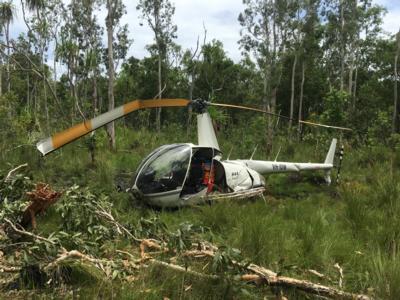Sun, Dec 10, 2023
Robinson R44 Downed from Fuel Exhaustion
The Australian Transport Safety Bureau released its final report regarding a February 2022 crash involving a Robinson R44 that killed 2.

The aircraft was engaged in a most unorthodox mission, being crewed by one pilot with reality TV star Matt Wright hooked into a 100-foot sling line dangling below. Wright, the “Outback Wrangler”, was along for the ride in an effort to gather and collect crocodile eggs, the arrangement being a somewhat standard technique in such circles as “human slinging”. The incident report is a real eye-opener, with one poor decision after another resulting in an unsurprising, but not wholly unexpected end. Deferred maintenance, cocaine, and improper procedures may have contributed to an error chain in some permutation of the incident, but in this case, the R44 was brought down by simple fuel exhaustion like so many other run-of-the-mill accidents.
In a particularly macabre turn, the pilot had been flying above a survivable freefall altitude for his slung companion, and released the passenger during the fuel starvation-induced autorotation. The pilot completed the maneuver to the ground, but there was “insufficient main rotor energy to cushion the landing” per the ATSB report. Of note to some is that previous rulemaking in Australia had imposed a limit to tethered passenger flight during egg collecting operations: Pilots were required to stay low enough that any incident like the above would not be a guaranteed fatal drop when they cut the sling-passenger loose. Additional regulations now require a turbine-engine helicopter for human slinging operations
Of course, like any such incident on the fringes of civilization, there were more issues that came to light during the investigation process. Though not at fault for the fatalities, “. engine defects present at the time of the accident likely affected the engine’s maximum power output and fuel consumption. Additionally, Helibrook had likely overrun the helicopter's maintenance, inspection and overhaul periods, which increased the likelihood of the helicopter experiencing a technical failure or malfunction.”
The ATSB also found evidence of cocaine exposure in the pilot's bloodstream from the days leading to the accident. Finally, the aircraft’s emergency locator transmitter had been removed from its mounting prior to the accident, preventing it from activating automatically and impeding emergency responders.
More News
He Attempted To Restart The Engine Three Times. On The Third Restart Attempt, He Noticed That Flames Were Coming Out From The Right Wing Near The Fuel Cap Analysis: The pilot repor>[...]
Make Sure You NEVER Miss A New Story From Aero-News Network Do you ever feel like you never see posts from a certain person or page on Facebook or Instagram? Here’s how you c>[...]
From 2009 (YouTube Edition): Leading Air Show Performers Give Their Best Advice for Newcomers On December 6th through December 9th, the Paris Las Vegas Hotel hosted over 1,500 air >[...]
Aero Linx: NASA ASRS ASRS captures confidential reports, analyzes the resulting aviation safety data, and disseminates vital information to the aviation community. The ASRS is an i>[...]
“For our inaugural Pylon Racing Seminar in Roswell, we were thrilled to certify 60 pilots across our six closed-course pylon race classes. Not only did this year’s PRS >[...]
 NTSB Final Report: Rutan Long-EZ
NTSB Final Report: Rutan Long-EZ ANN FAQ: Turn On Post Notifications
ANN FAQ: Turn On Post Notifications Classic Aero-TV: ICAS Perspectives - Advice for New Air Show Performers
Classic Aero-TV: ICAS Perspectives - Advice for New Air Show Performers ANN's Daily Aero-Linx (06.28.25)
ANN's Daily Aero-Linx (06.28.25) Aero-News: Quote of the Day (06.28.25)
Aero-News: Quote of the Day (06.28.25)



